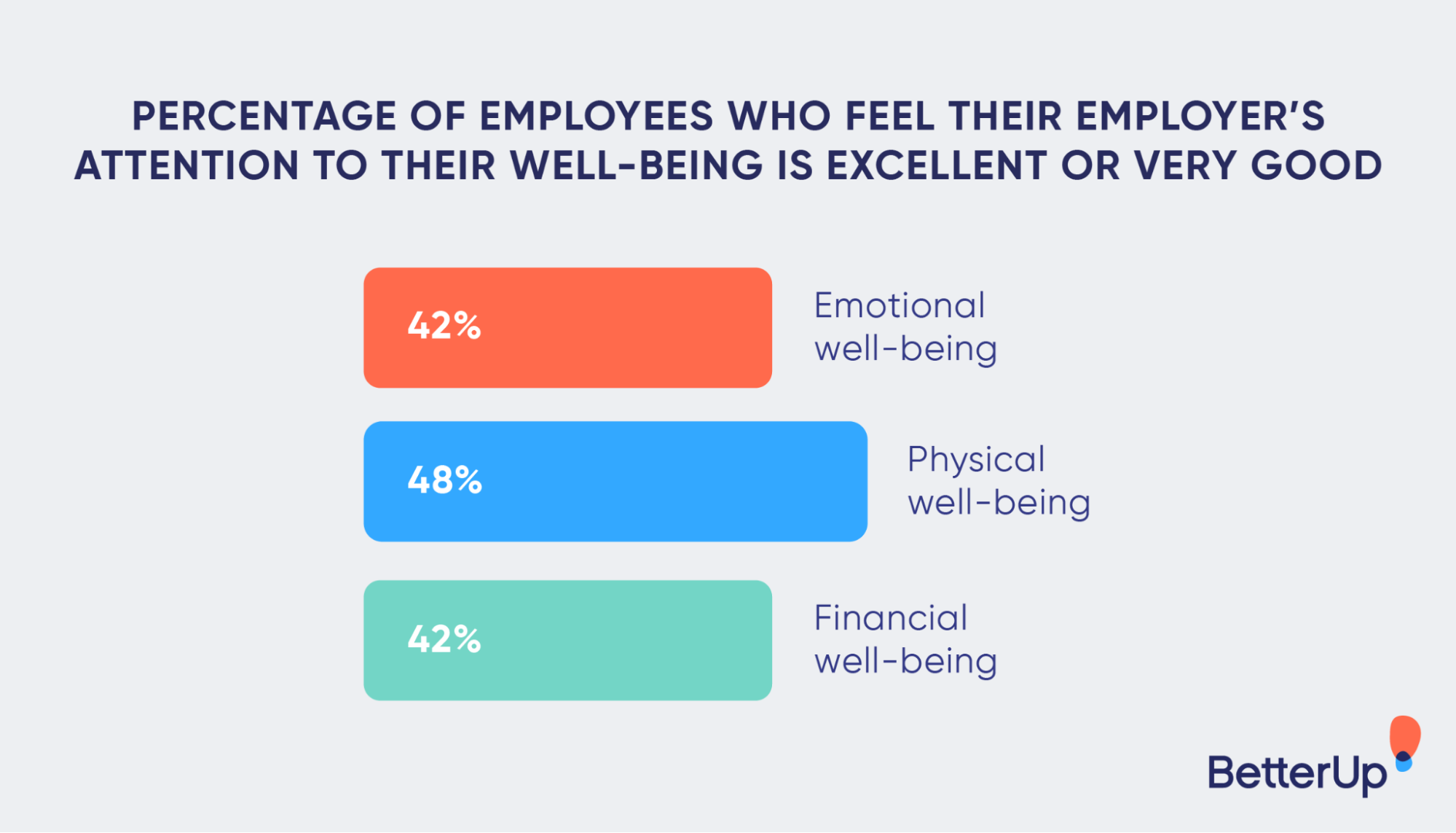Employee wellness used to mean offering comprehensive healthcare benefits. But now, healthcare is merely the tip of the iceberg when it comes to supporting employee well-being.
Many employee wellness programs now encompass a more nuanced understanding of well-being. Instead of only focusing on physical health, programs now offer support for mental, emotional, and financial health, too.
Wellness programs are becoming increasingly common in companies of all sizes. But what do they do, and how do they work?
Let's take a look at what employee well-being is, its importance in the workplace, and how to create a wellness program your employees will love.
How do you define employee wellness?

Employee and workplace burnout is much more than a buzzword. The stressors of a modern work environment can start to wear on employees. This stress has a direct impact on their physical and mental well-being.
Employee wellness includes activities and programs that aim to improve employee health and well-being. Prioritizing employee well-being is the main way an employer can help employees manage stress, build relationships, improve productivity, and reduce burnout.
As we begin to better understand the impacts stress and exhaustion can have on the body, it’s becoming more obvious that we need to address mental health at work.
After all, when employees feel supported, they’re more likely to do exceptional work. Wellness programs can play a key role in improving employee engagement and reducing turnover.
Even though 80% of employers claim to support their teams’ physical and emotional health, only 46% of employees feel supported. Effective employee wellness programs involve understanding what benefits best serve your employees’ needs.
Examples of employee wellness programs

There are plenty of easy, employee-friendly well-being options to expand your workplace wellness. Here are a few ideas for each area of employee health to get you started.
Physical health
Design fun fitness challenges to foster healthy competition in the office. These challenges keep employees engaged. This can lead to higher turnout for less popular initiatives like wellness screenings.
Mental health
Yoga and meditation are popular choices for decreasing stress and improving mental health. Counseling resources and support hotlines offer ongoing support when employees need more help.
Emotional health
Coaching is a great way to help employees expand their capabilities, cater to their emotional health, and connect to their purpose. BetterUp offers personalized coaching that will help your employees grow not just as part of your team but also as individuals.
Volunteer days are another way to help employees tap into their personal meaning. While social challenges encourage employees to step outside their comfort zone.
Financial health
Personal finance lunch-and-learn events are a great way to support employees who need help with money management. Sponsoring portfolio reviews can help your team learn to invest wisely and prepare for the future.
Why employee wellness is a priority in the workplace
Happy and healthy employees aren’t just more enjoyable to be around. They can also make your business more profitable and desirable to new talent.
Wellness programs are becoming table stakes for companies looking to attract top talent. As of 2019, 58% of companies offer wellness benefits to support their employees and reduce workplace stress.
Well-being benefits were important in 2020 for obvious reasons. During the pandemic, 30% of Americans showed symptoms of anxiety, depression, or both.
Mental health plays a critical role in an employee’s success at work. There’s no doubt that work demands can be a frequent source of stress for employees.
Companies like Chevron are going all-in to support employees and foster mental health. Their program is a great example of wellness benefits done right.
Mental health screenings and onsite child care empower employees to do their best work, even when times are tough. While campaigns to raise awareness also reduce the stigma surrounding mental health.
What the research says about employee wellness

Holistic wellness programs are becoming even more important to employees after COVID-19.
Many employers already had access to employee assistance programs. But only 20% of employees felt that their needs were met in the first few months of the pandemic. According to research from Kronos, the companies that prioritized wellness in 2020 saw a 33% increase in employee trust.
Some studies show that employee wellness programs fall short of their anticipated benefits. With that said, there’s a chance that many employees may not know what well-being benefits are available to them.
According to a study conducted by the Society for Human Resource Management, many companies with wellness programs say that less than 10% of employees use their benefits.
Employees hesitate to use wellness programs when business leaders don’t support the initiatives.
It’s important to promote benefits and encourage employees to use them. Offering a wide array of benefit types can also help engage employees looking for support beyond physical wellness.
Mental health services and financial well-being services are more widespread since COVID-19. And since more employees report that their financial wellness is declining, these types of benefits can have a huge impact on any team.
Companies like Noodles & Co. are leading the way in financial wellness benefits. The company has lower turnover and higher financial wellness ratings. They did this by offering early pay access and financial management services to employees.
The benefits of employee wellness programs

Businesses can reap surprising benefits from developing appealing wellness programs. Creating a happier, healthier workplace is a major asset for growing companies.
Here are four ways that supporting your employees can impact the bottom line.
1. Higher employee engagement
Workplace stress is one of the leading causes of lack of engagement and absenteeism. Addressing mental health through wellness programs can decrease employee stress.
When you manage stress, employees have lower absenteeism rates and higher morale. High employee morale leads to better relationships with teammates and more successful projects.
2. Lower turnover rate
Employees are likely to stay at companies where they feel appreciated and valued.
Wellness programs are a great way to show your commitment to your employees. While well-being programs also help to retain top talent.
3. Better company culture
Wellness programs often reflect the organization’s values. Executive support for employee well-being is a strong indicator that a company is a great place to work.
A clear commitment to employee wellness shows that you value happy, healthy employees. Over time, this supportive approach becomes reflective of your company’s culture.
4. Higher productivity
Fifty-seven percent of employees see a connection between their well-being and productivity. It makes sense that when employees don’t prioritize their wellness, work can begin to suffer.
Supporting employees with physical, mental, emotional, and financial wellness services takes the focus off their struggles and allows them to focus on work.

4 elements of a successful employee wellness program
The right encouragement goes a long way in creating a successful well-being program. But, without clear sponsorship and promotion, there’s a good chance your program could flop.
Here are four tips to increase engagement and encourage your employees to prioritize their own health and well-being.
1. Awareness of benefits
Clear, regular communications ensure employees know about their benefits. This will also encourage them to use them.
2. Participation in challenges
A wellness challenge is a fun and easy way to drive employees to develop healthy habits. Design appropriate challenges that appeal to different workers. These challenges can address many areas of well-being.
These fun challenges are a great way to engage your employees:
- Month-long yoga challenge for physical wellness
- 3-month automated savings challenge for financial wellness
- 7-day meditation challenge in the office for mental and emotional wellness
- One-time “pay it forward” challenges for social wellness, like paying for someone’s drink behind you in the drive-thru.
Depending on the individuals, some employees may benefit from participating in physical or mental health challenges. Others may feel more engaged with social and financial health challenges.
Short competitions that introduce team members to the resources available can enhance the success of your wellness program.
3. Strong leadership sponsorship
If employees see leaders using employee wellness programs at work and using wellness benefits, they’re more likely to try them. This is especially true of wellness initiatives that happen during the workday. Seeing or hearing about leaders participating will put employees at ease about stepping away from their desks.
For example, if your company wants to offer mid-day online yoga classes, encourage managers to invite team members to take part. This keeps employees from feeling that they may be punished for using their benefits.
4. Requesting regular feedback
Understanding what your employees want is an integral part of developing a program.
Think beyond saving on healthcare costs and see what will help your team thrive. You can even conduct regular surveys to better understand how your employees are doing. This will also help you understand what support would most benefit your team.
5 steps to starting an employee wellness program

An office wellness program is always evolving. So there is no need to start building an all-inclusive wellness center right now. Start off small and gradually encourage employees to embrace healthy lifestyle choices, like exercising, eating healthy, and quitting unhealthy habits.
Here are five steps to take to create a corporate wellness program that your employees will love.
1. Survey employees
Anonymously ask employees what services they would find most valuable.
Make sure to ask whether they’d prefer onsite resources, referrals, or reimbursement for external resources.
2. Identify program sponsors
Find employees who are passionate about wellness and committed to encouraging employees. Executive buy-in is essential to a successful employee wellness program.
Sponsors contribute by showcasing healthy behavior and participating in wellness initiatives. At the end of the day, this will inspire other employees to prioritize their health.
3. Form a wellness committee
Choose a group of employees dedicated to bringing well-being to your organization. Have them form a committee and serve as change champions to develop a program that best serves your employees.
This committee handles reviewing survey data, choosing popular initiatives, creating challenges, and more.
4. Define your goals
Work with your sponsors and committee members to determine objectives for your program.
For example, suppose your employees want to improve their physical health. You can set one goal for how many employees participate in an initial wellness screening and another goal for how many join a challenge.
Create goals for all the wellness initiatives in your program to track your success.
5. Find the right wellness resources
Once you know which services you need, speak with different vendors to explore solutions you can add to your wellness program. There’s no need to pick one vendor and implement every initiative they offer just because it’s part of a package.
For example, if smoking isn’t common in your office, smoking cessation may not be a program you want to include in your wellness benefits. Meanwhile, you may want to offer more robust resources for healthy eating.
Focus on the resources that will be most valuable for your team instead of those that impact your corporate health plan costs.
Examples of companies leaning into employee wellness
These companies lead the way in providing exceptional wellness support.
See what these four companies are doing to promote wellness within their organization.
Microsoft
Microsoft prioritizes employee wellness with health screening events, onsite health care services, and tons of physical activity like free Zumba classes, walking and running tracks, and sports courts.
Onsite grocery shopping and cafes with healthy food options make eating healthy even easier for their team.
Asana
Unlimited PTO, daily yoga programs, nap rooms, and an in-house culinary team serving three meals a day round out this tech company’s impactful wellness program.
Motley Fool
Physical and mental wellness is of prime importance to the Motley Fool team. Along with free fitness classes and personal training sessions, they offer a 50% reimbursement for race enrollment fees.
Zappos
Miss recess? Get it back at Zappos. Employees spend an hour a day in active fun. Plus, Zappos recently added a jam room to let employees relax with free music lessons and access to instruments.
Make employee well-being a top priority in your organization
Prioritizing your employees’ wellness is a must. Employee well-being programs are shifting from a “nice-to-have” to an essential benefit. Try sharing these ideas with your team and see what feedback you get. Once you have a few options that employees are excited about, you can start to roll them out.
Prioritize your well-being
Coaching helps you build habits that support mental clarity, physical health, and emotional balance.
Prioritize your well-being
Coaching helps you build habits that support mental clarity, physical health, and emotional balance.

-1.png)










